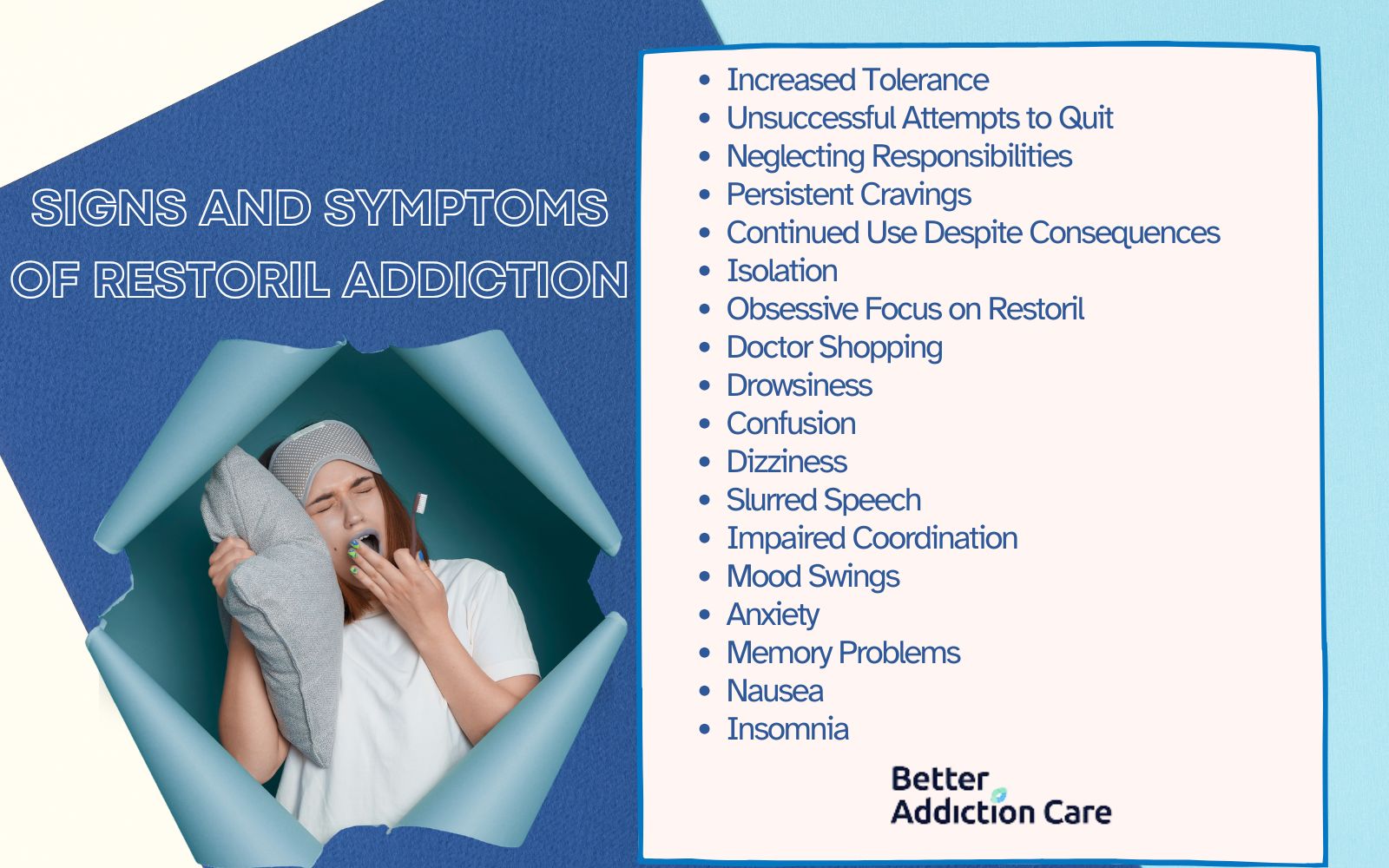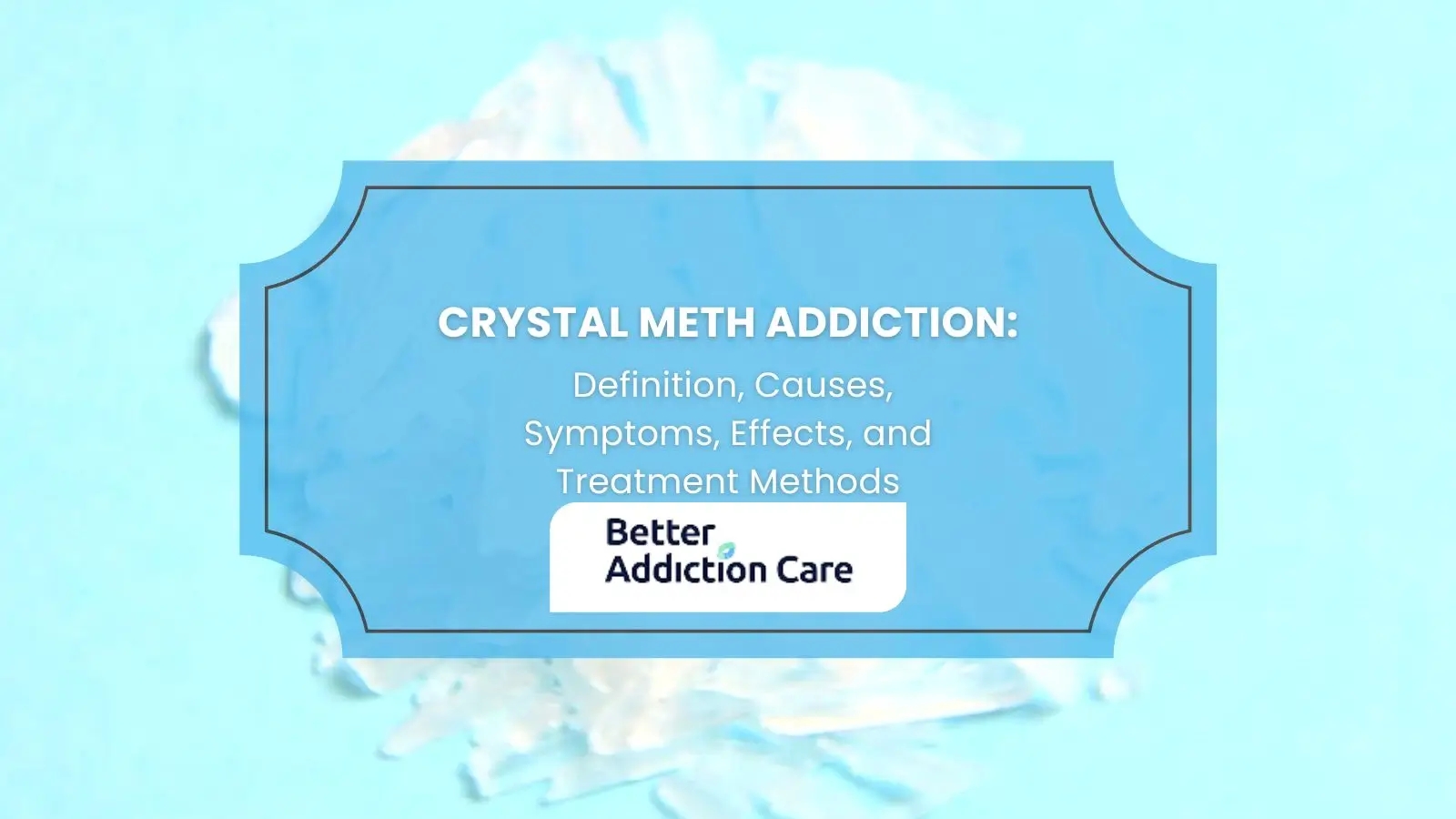Restoril Addiction: Signs, Causes, Effects, and Treatment
Restoril, or temazepam, refers to a benzodiazepine prescribed for short-term treatment of insomnia. According to the National Institute on Drug Abuse (NIDA), benzodiazepines like Restoril are effective for short-term use but carry significant risks of dependence when used beyond the prescribed duration.
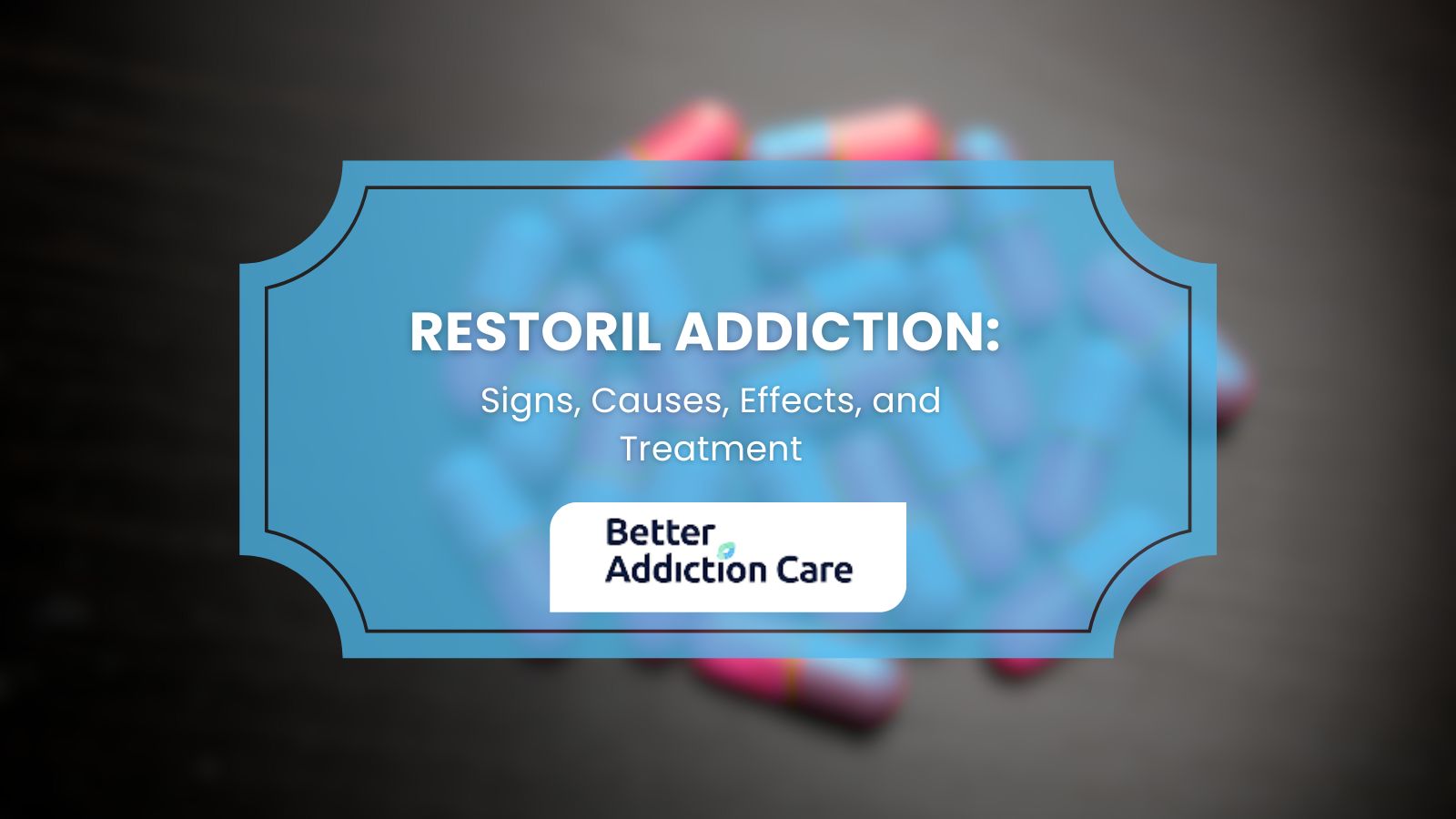
Restoril, or temazepam, refers to a benzodiazepine prescribed for short-term treatment of insomnia. According to the National Institute on Drug Abuse (NIDA), benzodiazepines like Restoril are effective for short-term use but carry significant risks of dependence when used beyond the prescribed duration.
Signs of Restoril addiction include increased tolerance, withdrawal symptoms such as anxiety and insomnia, and compulsive drug-seeking behavior. A study by Dobbin et al. titled Association of Benzodiazepine Injection with the Prescription of Temazepam Capsules, published in Drug and Alcohol Review (2003) highlights these behavioral and physical markers as hallmarks of benzodiazepine dependence.
The causes of Restoril addiction include prolonged use, genetic predisposition, and co-occurring mental health disorders like anxiety and PTSD. According to a study by Garretty et al. titled Benzodiazepine Misuse by Drug Addicts, published in the Annals of Clinical Biochemistry (1997), individuals with a history of other substance addictions are particularly vulnerable to benzodiazepine misuse.
Common health effects of Restoril addiction include drowsiness, confusion, and impaired coordination, while serious effects include respiratory depression and increased overdose risk when combined with other substances. The Substance Abuse and Mental Health Services Administration (SAMHSA) reports that benzodiazepines like Restoril are involved in over 30% of prescription drug overdose deaths, underscoring the severity of misuse.
Treatment options for Restoril addiction include medication-assisted treatment (MAT), behavioral therapies like CBT, and structured aftercare to prevent relapse. According to the National Institute on Drug Abuse (NIDA), combining MAT with therapies significantly reduces relapse risk and improves recovery outcomes for benzodiazepine addiction.
What is Restoril Addiction?
Restoril addiction is the compulsive and uncontrollable use of the benzodiazepine medication Restoril, exceeding prescribed dosages or using it without medical supervision.
Restoril, known generically as temazepam, is a sedative-hypnotic medication primarily prescribed to treat insomnia by inducing and maintaining sleep. However, due to its effects on the central nervous system, the drug has a high potential for misuse, dependence, and addiction.
Restoril abuse begins when individuals develop tolerance to the prescribed dose, leading to escalated use. Tolerance occurs as the brain adapts to the drug, diminishing its effects over time. Dependence follows when the body requires the drug to function normally, and withdrawal symptoms emerge when use is stopped.
A study by Garretty et al. (1997), titled Benzodiazepine Misuse by Drug Addicts, published in the Annals of Clinical Biochemistry, highlights that temazepam misuse is common among individuals who also misuse other substances, with its popularity driven by its potent sedative effects.
Data from the National Institute on Drug Abuse (NIDA) indicates that benzodiazepine misuse, including Restoril, is widespread, with over 12.5% of adults in the United States having used benzodiazepines in the past year and a significant proportion engaging in misuse. The study further states that misuse involves obtaining the medication illicitly or taking higher-than-prescribed doses.
Temazepam’s availability in both capsule and tablet forms contributes to its misuse potential. For example, soft gel capsules are particularly prone to injection misuse among intravenous drug users, as documented by Dobbin et al. (2003) in Drug and Alcohol Review, which found that tampering with temazepam gel capsules significantly increases the risks of vascular damage and dependence.
Restoril addiction is a critical public health concern that requires addressing its medical and social implications, particularly as tolerance, dependence, and misuse contribute to its escalating rates.
What is Restoril?
Restoril, generically known as temazepam, is a prescription medication classified as a benzodiazepine. Benzodiazepines are central nervous system depressants that enhance the effect of the neurotransmitter gamma-aminobutyric acid (GABA), which reduces brain activity. This action produces a calming effect, making Restoril effective in treating sleep-related disorders, particularly short-term insomnia.
Medically, Restoril is prescribed to help individuals fall asleep faster, maintain sleep throughout the night, and improve overall sleep quality. It is recommended for short-term use, generally lasting no more than 7 to 10 days, to prevent the development of tolerance and dependence.
The medication is available in capsule form, with common doses ranging from 7.5 mg to 30 mg, depending on the severity of the patient's condition.
Restoril is classified as a Schedule IV controlled substance under the Controlled Substances Act in the United States, signifying a lower potential for abuse compared to Schedule II or III drugs but still carrying a risk of dependence.
According to Dobbin et al. (2003), Restoril’s unique formulation, particularly the gel capsules, has been associated with misuse, especially among individuals injecting the drug to intensify its sedative effects. Despite these risks, Restoril remains a widely prescribed medication for managing insomnia, with millions of prescriptions issued annually.
The drug’s sedative-hypnotic properties make it an effective short-term solution for sleep disorders. Still, its classification as a benzodiazepine shows its potential for tolerance, dependence, and addiction when misused or taken for extended periods.
Why is Restoril Addictive
Restoril is addictive due to its profound effects on neurotransmitters in the brain and its potent sedative properties. As a benzodiazepine, Restoril enhances the activity of gamma-aminobutyric acid (GABA), a neurotransmitter that inhibits brain activity and induces a calming effect.
This action reduces anxiety, relaxes muscles, and promotes sedation, making it highly effective for short-term treatment of insomnia. However, these same effects contribute to the drug's addictive potential.
Prolonged use of Restoril alters the brain’s natural balance of neurotransmitters. Over time, the brain becomes reliant on the drug to maintain GABA activity, leading to tolerance—where higher doses are needed to achieve the same sedative effects.
Dependence follows as the brain struggles to function normally without the presence of the drug, resulting in withdrawal symptoms like anxiety, insomnia, and irritability when the medication is discontinued.
Restoril’s sedative properties play a significant role in its addictive nature. The rapid onset of sedation creates a reinforcing cycle, as users associate the drug with immediate relief from anxiety or sleep difficulties.
This leads to misuse, with individuals taking more than prescribed or using the drug without medical supervision to achieve its calming effects. A study by Degenhardt et al. (2008), published in Drug and Alcohol Review, highlights how the sedative effects of benzodiazepines like temazepam contribute to their misuse among vulnerable populations, including those seeking relief from stress or chronic insomnia.
Furthermore, the subjective experience of sedation, such as feelings of euphoria or profound relaxation, can drive psychological addiction. Repeated use to replicate these effects increases the risk of both physical and psychological dependence.
These factors, combined with the drug’s accessibility, show why Restoril is both effective as a medical treatment and highly prone to addiction when not used responsibly.
Is Restoril a Benzodiazepine?
Yes, Restoril is a benzodiazepine. This classification is based on a drug's chemical structure and mechanism of action on the central nervous system. Benzodiazepines are a group of psychoactive drugs known for their sedative, anxiolytic (anti-anxiety), muscle-relaxant, and anticonvulsant properties.
Restoril is a benzodiazepine because it binds to the gamma-aminobutyric acid-A (GABA-A) receptor in the brain.
The primary function of benzodiazepines, including Restoril, is to enhance the activity of GABA, the brain's primary inhibitory neurotransmitter. By increasing GABA’s effects, Restoril slows down nerve impulses in the brain, leading to reduced brain activity and a calming, sedative effect. This makes Restoril particularly effective for treating insomnia, as it helps users fall asleep faster and stay asleep longer.
Restoril's classification as a benzodiazepine also explains its potential for addiction, as this drug class is known for its high risk of tolerance, dependence, and misuse. According to the study by Garretty et al. (1997), benzodiazepines, including temazepam, are widely misused due to their fast-acting sedative properties, which users seek for relief from stress or to induce relaxation.
Benzodiazepines like Restoril are further divided into short-, intermediate-, and long-acting categories, depending on how quickly the effects start and how long they last. Restoril is considered an intermediate-acting benzodiazepine, making it suitable for nighttime use without causing excessive drowsiness the following day.
However, this intermediate duration also contributes to its misuse potential, as individuals use it frequently to sustain its sedative effects.
While Restoril is highly effective for its intended medical purpose, its classification as a benzodiazepine highlights the need for cautious use to avoid the risks associated with this drug family.
What are Signs and Symptomps of Restoril Addiction?
The signs and symptoms of Restoril addiction are physical dependence, behavioral changes, and psychological cravings. Physically, individuals experience tolerance, requiring increasingly higher doses to achieve the desired sedative effect, along with withdrawal symptoms such as anxiety, insomnia, muscle pain, and tremors when the drug is not taken.
Behaviorally, addiction manifests as doctor shopping, obtaining Restoril through illicit means, or neglecting responsibilities. Psychologically, a strong compulsion to use the drug, even when it causes harm, is a hallmark of addiction.
These signs are consistent with findings from Garretty et al. titled Benzodiazepine Misuse by Drug Addicts, published in the Annals of Clinical Biochemistry (1997), which reported that benzodiazepine misuse includes escalating use patterns and impaired ability to control consumption.
The signs and symptoms of Restoril addiction are explained below:
-
Increased Tolerance: Tolerance develops when the body adjusts to Restoril, requiring higher doses to achieve the same sedative effects. This is a physical sign of addiction and a precursor to dependence. According to a study by Garretty et al. titled Benzodiazepine Misuse by Drug Addicts, published in the Annals of Clinical Biochemistry (1997), tolerance to benzodiazepines like temazepam leads to escalating misuse as users seek to replicate the drug’s initial effects.
-
Unsuccessful Attempts to Quit: Addiction causes repeated failures to stop using Restoril, even when individuals recognize the harm it causes. This behavioral symptom reflects the strong psychological hold of the drug, which impairs self-control and perpetuates dependency.
-
Neglecting Responsibilities: Individuals addicted to Restoril frequently prioritize drug use over personal, professional, or social obligations. This sign of addiction disrupts daily life, highlighting the extensive behavioral impact of dependence.
-
Persistent Cravings: Cravings occur due to the drug’s alteration of the brain’s reward system, which reinforces compulsive use. These cravings are a psychological symptom, making it difficult for individuals to maintain abstinence.
-
Continued Use Despite Consequences: Restoril addiction is marked by continued use despite health issues, financial strain, or relationship problems. According to a study by Degenhardt et al. titled The Effects of the Market Withdrawal of Temazepam Gel Capsules, published in Drug and Alcohol Review (2008), benzodiazepine misuse persists even after significant adverse effects emerge.
-
Isolation: Addicted individuals withdraw from social interactions to conceal their drug use or due to feelings of guilt and shame. This behavioral sign further isolates them, exacerbating the psychological toll of addiction.
-
Obsessive Focus on Restoril: A key behavioral sign of addiction is a preoccupation with obtaining and using Restoril, which disrupts daily routines and diverts resources toward sustaining the habit.
-
Doctor Shopping: Seeking prescriptions from multiple providers to obtain more Restoril is a common behavioral sign of addiction. According to a study by Dobbin et al. titled Association of Benzodiazepine Injection with the Prescription of Temazepam Capsules, published in Drug and Alcohol Review (2003), this practice is prevalent among those misusing benzodiazepines.
-
Drowsiness: Restoril’s sedative effects frequently cause excessive drowsiness, a physical symptom that impairs functionality and increases the risk of accidents.
-
Confusion: Cognitive impairment, including disorientation and difficulty concentrating, is a symptom caused by the drug’s depressive effects on the central nervous system.
-
Dizziness: Dizziness, a common physical symptom, stems from Restoril’s interference with normal brain activity, leading to unsteadiness and disorientation.
-
Slurred Speech: The drug’s impact on brain activity leads to difficulty articulating words, a sign that often accompanies excessive use.
-
Impaired Coordination: Restoril disrupts motor control, causing clumsiness or difficulty performing physical tasks. This symptom increases the risk of injury and accidents.
-
Mood Swings: Emotional instability, such as rapid shifts between anger and sadness, is linked to Restoril’s influence on brain chemistry and is a psychological symptom of addiction.
-
Anxiety: Ironically, Restoril addiction results in heightened anxiety, particularly during withdrawal, highlighting the paradoxical effects of the drug.
-
Memory Problems: Restoril interferes with short-term memory formation, and chronic misuse exacerbates these cognitive deficits. This symptom is closely tied to its sedative properties.
-
Nausea: During withdrawal, nausea occurs as the body reacts to the absence of the drug, a physical symptom that underscores the severity of dependence.
-
Insomnia: Rebound insomnia develops during withdrawal, making it harder for individuals to abstain. This symptom perpetuates the cycle of misuse and dependence.
What Are the Causes of Restoril Addiction?
The causes of Restoril addiction are genetic predisposition, prolonged use, and mental health disorders. Genetic factors increase an individual’s vulnerability to addiction, making them more likely to misuse benzodiazepines like Restoril.
Prolonged or high-dose use of the drug significantly increases the risk of developing tolerance and dependence, as shown in studies like Dobbin et al.’s Association of Benzodiazepine Injection with the Prescription of Temazepam Capsules (2003), which highlights how misuse patterns emerge with extended access. Additionally, mental health conditions such as anxiety, PTSD, or depression lead to self-medication with Restoril, further driving addiction.
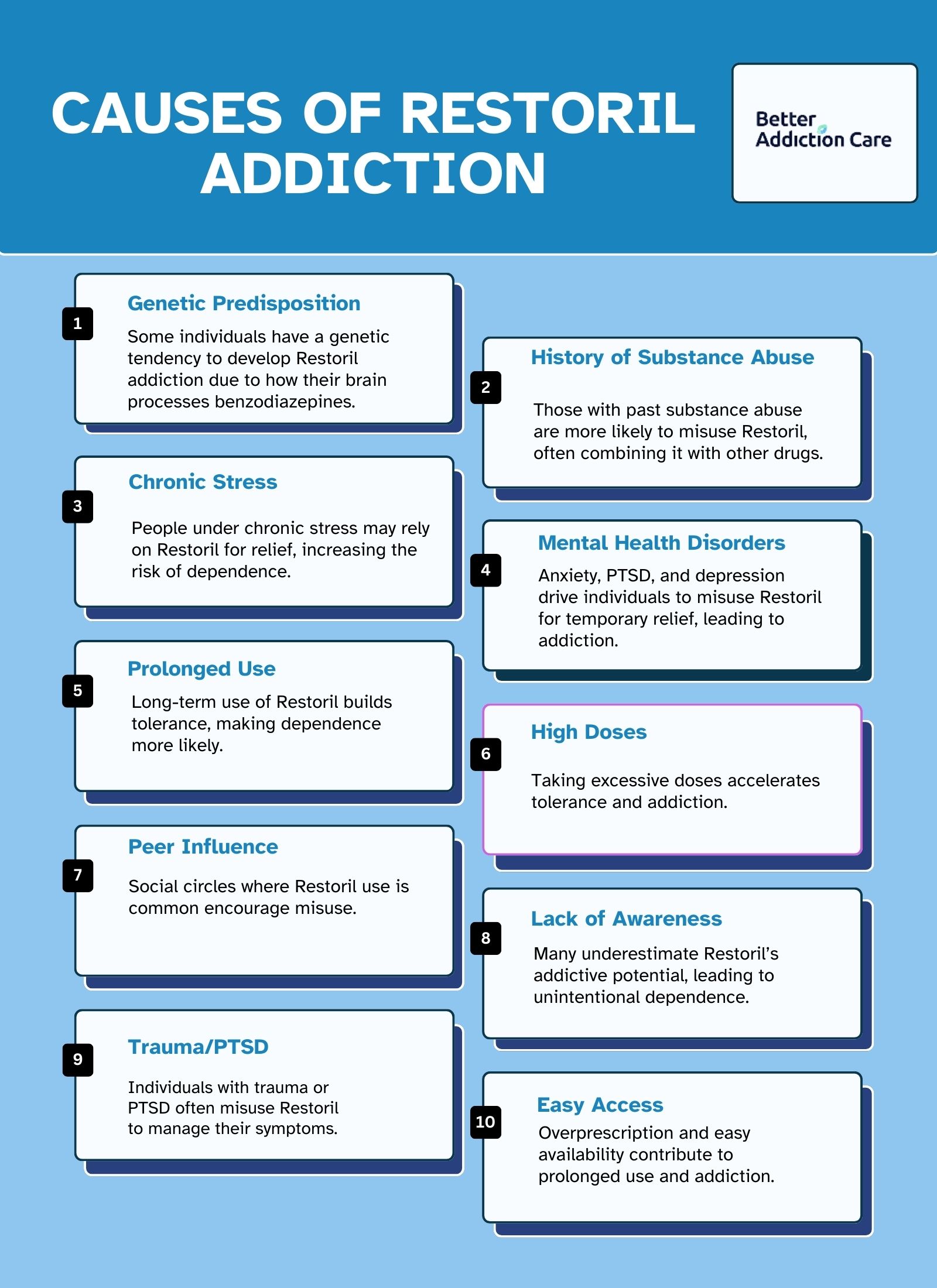
The causes of Restoril addiction are explained below:
-
Genetic Predisposition: Genetic factors increase the risk of developing Restoril addiction by influencing how the brain processes benzodiazepines. Some individuals are genetically predisposed to seek out substances that enhance GABA activity, leading to dependence. According to a study by Garretty et al. titled Benzodiazepine Misuse by Drug Addicts, published in the Annals of Clinical Biochemistry (1997), genetic vulnerability plays a critical role in benzodiazepine addiction by altering individual susceptibility.
-
History of Substance Abuse: A history of substance abuse predisposes individuals to Restoril addiction because they may use the drug to enhance the effects of other substances or to manage withdrawal symptoms. This is supported by a study by Degenhardt et al. titled The Effects of the Market Withdrawal of Temazepam Gel Capsules, published in Drug and Alcohol Review (2008), which found that benzodiazepine misuse is prevalent among polydrug users due to its sedative effects.
-
Chronic Stress: Chronic stress leads to Restoril addiction as individuals turn to the drug for its calming effects on the central nervous system. Restoril’s ability to suppress stress responses creates a dependency cycle. A study by Dobbin et al. titled Association of Benzodiazepine Injection with the Prescription of Temazepam Capsules, published in Drug and Alcohol Review (2003), highlights how stress-induced misuse is a significant driver of benzodiazepine dependence.
-
Mental Health Disorders: Conditions such as anxiety, PTSD, and depression result in Restoril addiction due to self-medication. Restoril’s sedative properties temporarily alleviate these conditions, increasing dependence. According to a study by Garretty et al. titled Benzodiazepine Misuse by Drug Addicts, published in the Annals of Clinical Biochemistry (1997), mental health disorders frequently co-occur with benzodiazepine misuse, fueling addiction.
-
Prolonged Restoril Use: Long-term use of Restoril leads to tolerance and dependence, as the brain becomes reliant on the drug for normal function. A study by Dobbin et al. titled Association of Benzodiazepine Injection with the Prescription of Temazepam Capsules, published in Drug and Alcohol Review (2003) found that prolonged access to benzodiazepines correlates directly with higher misuse rates.
-
High Doses of Restoril: High doses of Restoril overwhelm the brain’s neurotransmitter systems, accelerating tolerance and addiction. According to a study by Degenhardt et al. titled The Effects of the Market Withdrawal of Temazepam Gel Capsules, published in Drug and Alcohol Review (2008), high-dose misuse significantly increases the risk of dependence and associated harms.
-
Peer Influence: Social environments where Restoril misuse is normalized contribute to addiction, as peer behavior strongly influences individual habits.
-
Lack of Education About Addiction Risks: Misunderstanding the addictive potential of Restoril increases the likelihood of misuse. Misconceptions about the safety of prescription medications often lead to improper use. A study by Dobbin et al. titled Association of Benzodiazepine Injection with the Prescription of Temazepam Capsules, published in Drug and Alcohol Review (2003), states that a lack of awareness about misuse risks significantly contributes to addiction rates.
-
Trauma or PTSD: Trauma survivors and individuals with PTSD are at a heightened risk of Restoril addiction as they rely on the drug for relief from intrusive thoughts and anxiety. A study by Dobbin et al. titled Association of Benzodiazepine Injection with the Prescription of Temazepam Capsules, published in Drug and Alcohol Review (2003) found that benzodiazepine misuse is closely linked to managing trauma-related symptoms.
-
Easy Access to Prescriptions: Overprescribing and insufficient monitoring by healthcare providers increase the risk of Restoril addiction. Accessibility enables prolonged and unregulated use, which fosters dependence. According to a study by Dobbin et al. titled Association of Benzodiazepine Injection with the Prescription of Temazepam Capsules, published in Drug and Alcohol Review (2003), the ease of obtaining prescriptions is a key factor in benzodiazepine misuse.
Who is at Risk of Restoril Addiction?
People at risk of Restoril addiction are those with a history of substance abuse, chronic mental health disorders, and prolonged use of high-dose prescriptions. Individuals with a prior substance abuse history are more likely to misuse Restoril to enhance or substitute the effects of other drugs, as noted in a study by Degenhardt et al. titled The Effects of the Market Withdrawal of Temazepam Gel Capsules, published in Drug and Alcohol Review (2008).
Those suffering from anxiety, PTSD, or depression often self-medicate with Restoril, which increases dependency risks, as highlighted by Garretty et al. in Benzodiazepine Misuse by Drug Addicts, published in the Annals of Clinical Biochemistry (1997).
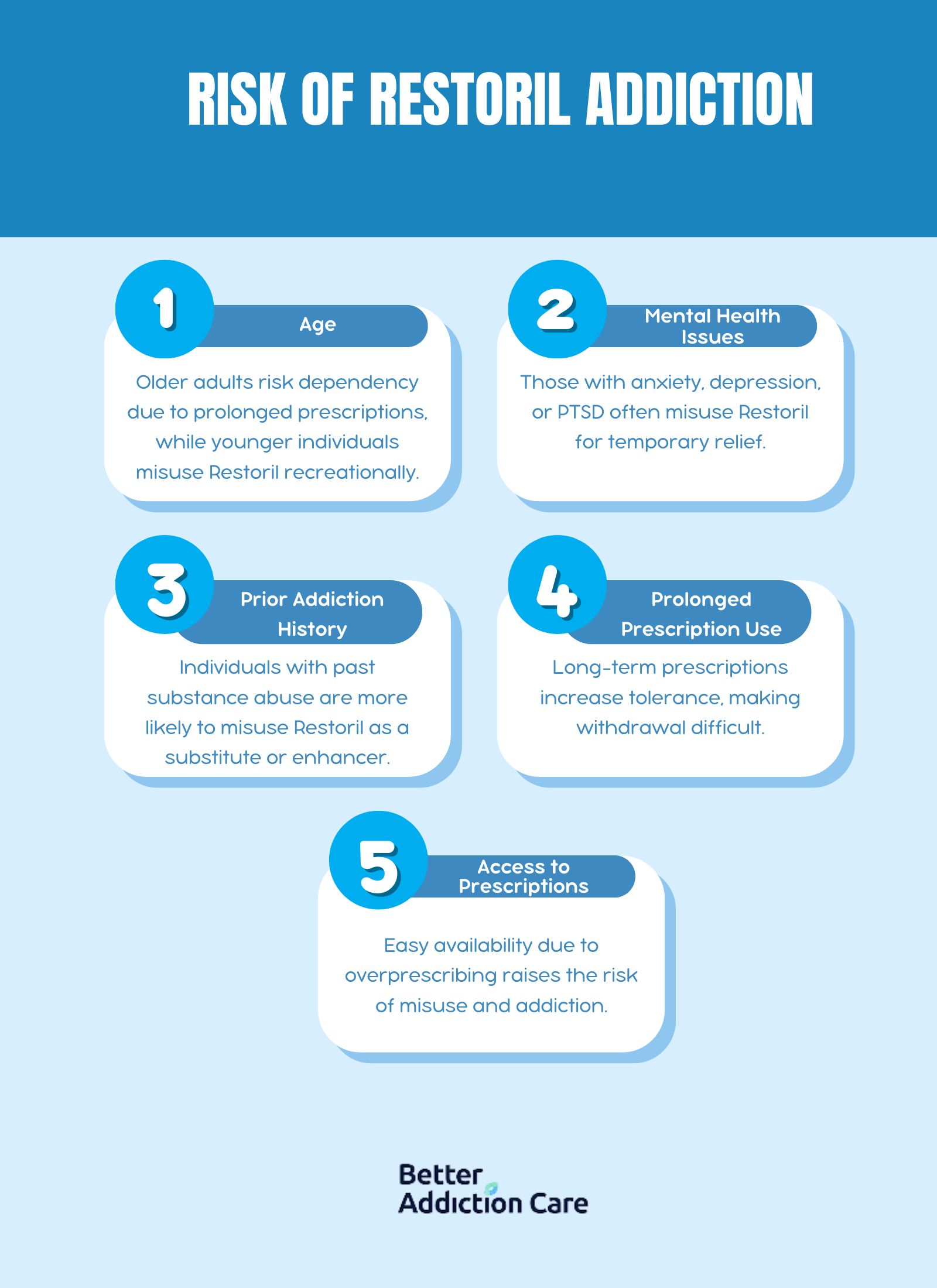
People at risk of Restoril addiction are explained below:
-
Age: Older adults and younger individuals are at increased risk for Restoril addiction. Older adults are prescribed benzodiazepines for insomnia or anxiety, leading to prolonged use and dependence, while younger individuals misuse the drug recreationally. A study by Garretty et al. titled Benzodiazepine Misuse by Drug Addicts, published in the Annals of Clinical Biochemistry (1997), highlights that misuse patterns vary by age, with older users developing dependency due to medical prescriptions.
-
Mental Health Issues: Individuals with mental health conditions such as anxiety, depression, or PTSD are more likely to misuse Restoril as a form of self-medication. According to a study by Degenhardt et al. titled The Effects of the Market Withdrawal of Temazepam Gel Capsules, published in Drug and Alcohol Review (2008), benzodiazepine misuse is prevalent among those seeking relief from mental health symptoms.
-
Prior Addiction History: A history of substance abuse significantly increases the risk of Restoril addiction, as individuals with prior addiction use it to enhance or substitute the effects of other substances. Research by Dobbin et al. titled Association of Benzodiazepine Injection with the Prescription of Temazepam Capsules, published in Drug and Alcohol Review (2003), found that Restoril misuse is common in polydrug users.
-
Prolonged Prescription Use: Individuals prescribed Restoril for long-term use are more likely to develop tolerance and dependence. Extended use alters brain chemistry, making it harder to stop without withdrawal symptoms.
-
Access to Prescriptions: People with easy access to benzodiazepine prescriptions, either through overprescribing or lenient monitoring, are at higher risk of misuse. This is particularly problematic in communities where prescription regulation is insufficient, as noted in research by Degenhardt et al. (2008).
How Long Does It Take to Become Dependent on Restoril?
It takes as little as two to four weeks to become dependent on Restoril, depending on the dose and frequency of use. Prolonged daily use, even at therapeutic doses, increases the likelihood of developing physical and psychological dependence.
A study by Dobbin et al. titled Association of Benzodiazepine Injection with the Prescription of Temazepam Capsules, published in Drug and Alcohol Review (2003) found that individuals using Restoril for longer than four weeks were at a substantially increased risk of developing dependence.
High doses or misuse of Restoril further accelerate this process, creating tolerance and the need for increasing quantities to achieve the same effect.
What Are the Side Effects of Restoril Addiction?
The side effects of Restoril addiction include drowsiness, impaired coordination, and memory problems. These effects result from the drug’s impact on the central nervous system, disrupting cognitive and physical functions.
According to the National Institute on Drug Abuse (NIDA), these effects occur as the drug alters brain function, impairing physical coordination and cognitive processes during both active use and withdrawal.
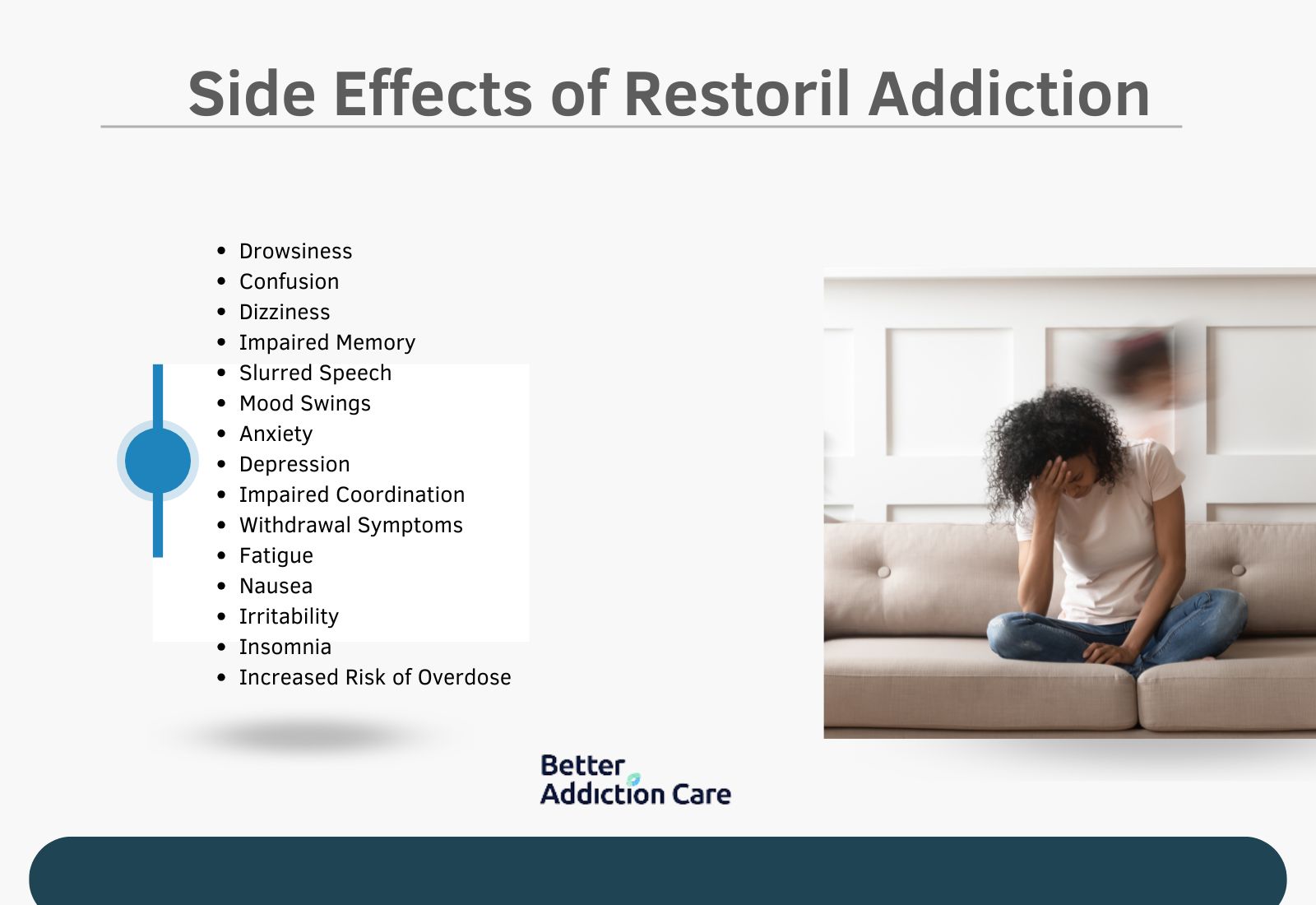
The side effects of Restoril addiction are explained below:
-
Drowsiness: Restoril enhances the activity of GABA, the brain's primary inhibitory neurotransmitter, leading to decreased neural activity and excessive drowsiness. The National Institute on Drug Abuse (NIDA) states that benzodiazepines like Restoril suppress brain function, causing lethargy and impairing daytime alertness.
-
Confusion: Chronic use of Restoril disrupts cognitive processing, leading to difficulty concentrating and making decisions. A study by Degenhardt et al. titled The Effects of the Market Withdrawal of Temazepam Gel Capsules, published in Drug and Alcohol Review (2008) highlights cognitive fog as a significant side effect of prolonged benzodiazepine misuse.
-
Dizziness: Restoril’s central nervous system depressant effects interfere with inner ear balance and neural communication, causing dizziness. According to Dobbin et al.’s Association of Benzodiazepine Injection with the Prescription of Temazepam Capsules, published in Drug and Alcohol Review (2003), this symptom is common among those misusing benzodiazepines.
-
Impaired Memory: Restoril inhibits memory formation by suppressing hippocampal activity, leading to short-term memory loss. The National Institute of Health (NIH) reports that benzodiazepines significantly impair memory recall and contribute to cognitive decline with long-term use.
-
Slurred Speech: Restoril slows neural communication, impacting muscle control required for clear speech. Garretty et al.’s study titled Benzodiazepine Misuse by Drug Addicts, published in the Annals of Clinical Biochemistry (1997), identifies slurred speech as a common sign of misuse.
-
Mood Swings: The drug's influence on neurotransmitters causes sudden emotional shifts, ranging from euphoria to irritability. This effect is consistent with findings by Dobbin et al. (2003), which note emotional instability as a hallmark of benzodiazepine dependence.
-
Anxiety: Paradoxically, long-term Restoril use worsens anxiety symptoms, especially during withdrawal. According to NIDA, benzodiazepine addiction often leads to heightened anxiety as the brain becomes reliant on the drug to regulate stress.
-
Depression: Chronic Restoril use disrupts the brain's natural balance of neurotransmitters, contributing to depressive symptoms. The NIH highlights the strong correlation between benzodiazepine dependency and the onset of depression.
-
Impaired Coordination: Restoril affects motor control by depressing the cerebellum, leading to clumsiness and reduced reaction times. As Garretty et al.’s study on benzodiazepine misusenoted, this symptom increases the risk of accidents.
-
Withdrawal Symptoms: Symptoms like restlessness, agitation, and insomnia occur as the brain struggles to adjust to the absence of Restoril. The severity of withdrawal symptoms in individuals dependent on benzodiazepines.
-
Fatigue: Restoril’s sedative effects persist even during waking hours, causing chronic tiredness. NIDA reports that persistent fatigue is common in benzodiazepine addiction due to prolonged nervous system suppression.
-
Nausea: Withdrawal from Restoril includes nausea as the body reacts to the absence of the drug. Nausea is a primary physical withdrawal symptom.
-
Irritability: Changes in neurotransmitter levels during Restoril addiction result in heightened irritability and agitation. These behavioral symptoms are indicative of dependency and withdrawal stress.
-
Insomnia: Restoril dependency leads to rebound insomnia, where sleep becomes impossible without the drug. According to NIDA, benzodiazepine addiction exacerbates the very conditions it is prescribed to treat.
-
Increased Risk of Overdose: Combining Restoril with other central nervous system depressants, such as alcohol, amplifies its sedative effects, significantly increasing overdose risk. According to the National Institute on Drug Abuse (NIDA), in its report Polydrug Use and Overdose Risks (2021), 80% of benzodiazepine misuse cases, including Restoril, involve concurrent use with substances like alcohol or opioids, significantly heightening the risk of overdose.
What Are the Withdrawal Symptoms of Restoril?
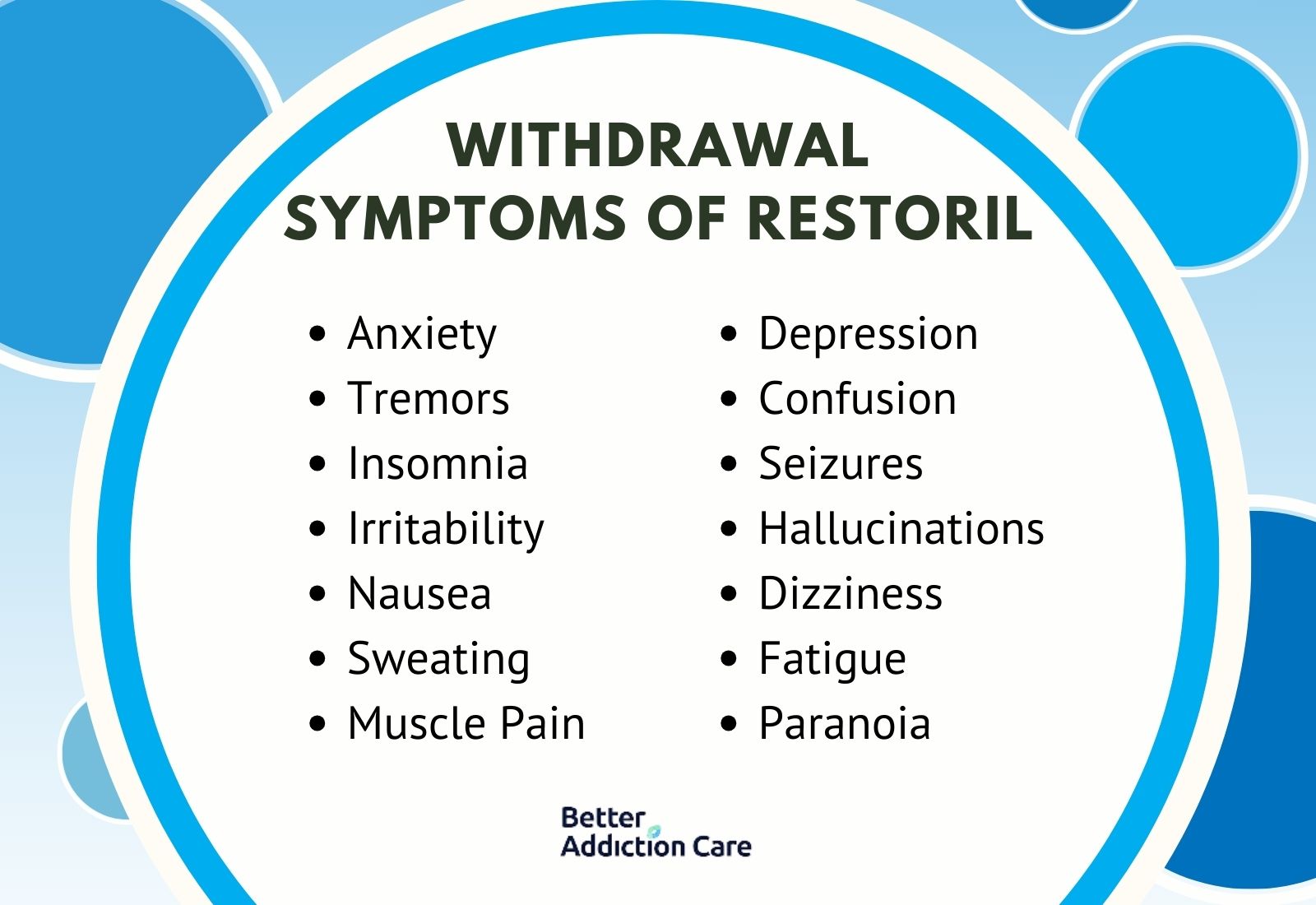
The withdrawal symptoms of Restoril include the following:
-
Anxiety: Anxiety during withdrawal is a severe psychological symptom and manifests as excessive worry, restlessness, and difficulty calming down. This occurs because the brain, having relied on Restoril to regulate stress through GABA activity, struggles to maintain equilibrium. According to the National Institute on Drug Abuse (NIDA), anxiety is one of the most common symptoms of benzodiazepine withdrawal as the body adjusts to the absence of the drug.
-
Tremors: Involuntary shaking, particularly in the hands and arms, is a physical symptom that results from heightened neural activity when the calming effects of Restoril are removed. A study by Dobbin et al. titled Association of Benzodiazepine Injection with the Prescription of Temazepam Capsules, published in Drug and Alcohol Review (2003) identifies tremors as a significant physical symptom of benzodiazepine withdrawal.
-
Insomnia: Rebound insomnia is a psychological symptom where individuals find it nearly impossible to sleep due to the brain’s inability to regulate sleep without Restoril naturally. This exacerbates other psychological symptoms like anxiety and irritability, creating a vicious cycle.
-
Irritability: Irritability during withdrawal is a psychological symptom characterized by heightened emotional sensitivity, frequent outbursts, and difficulty maintaining calm. This occurs as the brain adjusts to disrupted neurotransmitter activity, a process described by NIDA as a common benzodiazepine withdrawal effect.
-
Nausea: Nausea and vomiting are physical symptoms that arise as the body reacts to the absence of Restoril, particularly during the early stages of withdrawal. This symptom reflects the central nervous system’s struggle to stabilize, as noted by Degenhardt et al. in The Effects of the Market Withdrawal of Temazepam Gel Capsules, published in Drug and Alcohol Review (2008).
-
Sweating: Excessive sweating, even in the absence of physical exertion, is a physical symptom caused by overactivation of the body’s autonomic nervous system during withdrawal. This symptom can be distressing and contribute to discomfort and dehydration.
-
Muscle Pain: Generalized muscle aches and spasms are physical symptoms that occur due to the body’s sudden loss of Restoril’s muscle-relaxant effects. These pains often intensify during physical activity and can linger for weeks.
-
Depression: Withdrawal frequently triggers the psychological symptoms of depression, marked by feelings of sadness, hopelessness, and low energy. This occurs as the brain’s neurotransmitter systems, particularly serotonin, attempt to rebalance after prolonged Restoril use.
-
Confusion: Cognitive fog, including difficulty concentrating or processing information, is a common psychological sign. This symptom results from the brain's adaptation to functioning without the suppressive effects of Restoril on neural activity.
-
Seizures: In severe cases, Restoril withdrawal leads to physical symptoms of seizures due to the brain’s hyperactivity. The risk of seizures is one of the most dangerous physical symptoms associated with benzodiazepine withdrawal.
-
Hallucinations: Visual or auditory hallucinations are rare but severe psychological symptoms resulting from extreme neural overstimulation. These symptoms are disorienting and require immediate medical attention.
-
Dizziness (Physical): Lightheadedness and balance issues are physical symptoms that occur as the body struggles to regulate blood pressure and inner ear functions without the drug’s influence.
-
Fatigue (Physical): Persistent exhaustion, despite adequate rest, results from the physical and mental strain of withdrawal. This physical symptom reflects the body’s recovery efforts as it works to restore normal functioning.
-
Paranoia: Irrational fears or distrust are psychological symptoms tied to the overstimulated state of the brain. These symptoms lead to isolation and exacerbate other emotional distress during withdrawal.
Does Restoril Need to be Weaned?
Yes, Restoril needs to be weaned to prevent severe withdrawal symptoms such as seizures, anxiety, and insomnia. Gradual dosage reduction allows the brain to adjust to lower levels of the drug, minimizing the risk of dangerous physical and psychological effects.
According to the National Institute on Drug Abuse (NIDA), tapering benzodiazepines under medical supervision is the safest method to discontinue use, as abrupt cessation leads to life-threatening complications.
A carefully managed tapering schedule helps alleviate withdrawal discomfort and reduces the likelihood of relapse.
What is The Withdrawal Timeline for Restoril?
The withdrawal timeline for Restoril is 1 to 4 weeks, with symptoms starting within 24 to 48 hours after the last dose. Acute symptoms, such as anxiety, tremors, and insomnia, are most severe during the first 7 to 10 days.
These symptoms gradually decrease over the next 2 to 3 weeks as the body adjusts to the absence of the drug. According to the National Institute on Drug Abuse (NIDA), the duration and intensity of withdrawal depend on factors such as dosage, duration of use, and individual health conditions.
What are the Treatment Options for Restoril Addiction?
The treatment options for Restoril addiction include inpatient and outpatient rehabilitation programs, behavioral therapies, and medication-assisted treatment (MAT). These approaches address both the physical and psychological aspects of addiction, increasing the likelihood of recovery.
According to the National Institute on Drug Abuse (NIDA), integrated treatment programs that combine therapy and medication show a success rate of up to 60% in achieving long-term sobriety for benzodiazepine addiction. Such programs provide medical supervision during withdrawal, counseling to address underlying issues, and ongoing support to prevent relapse.
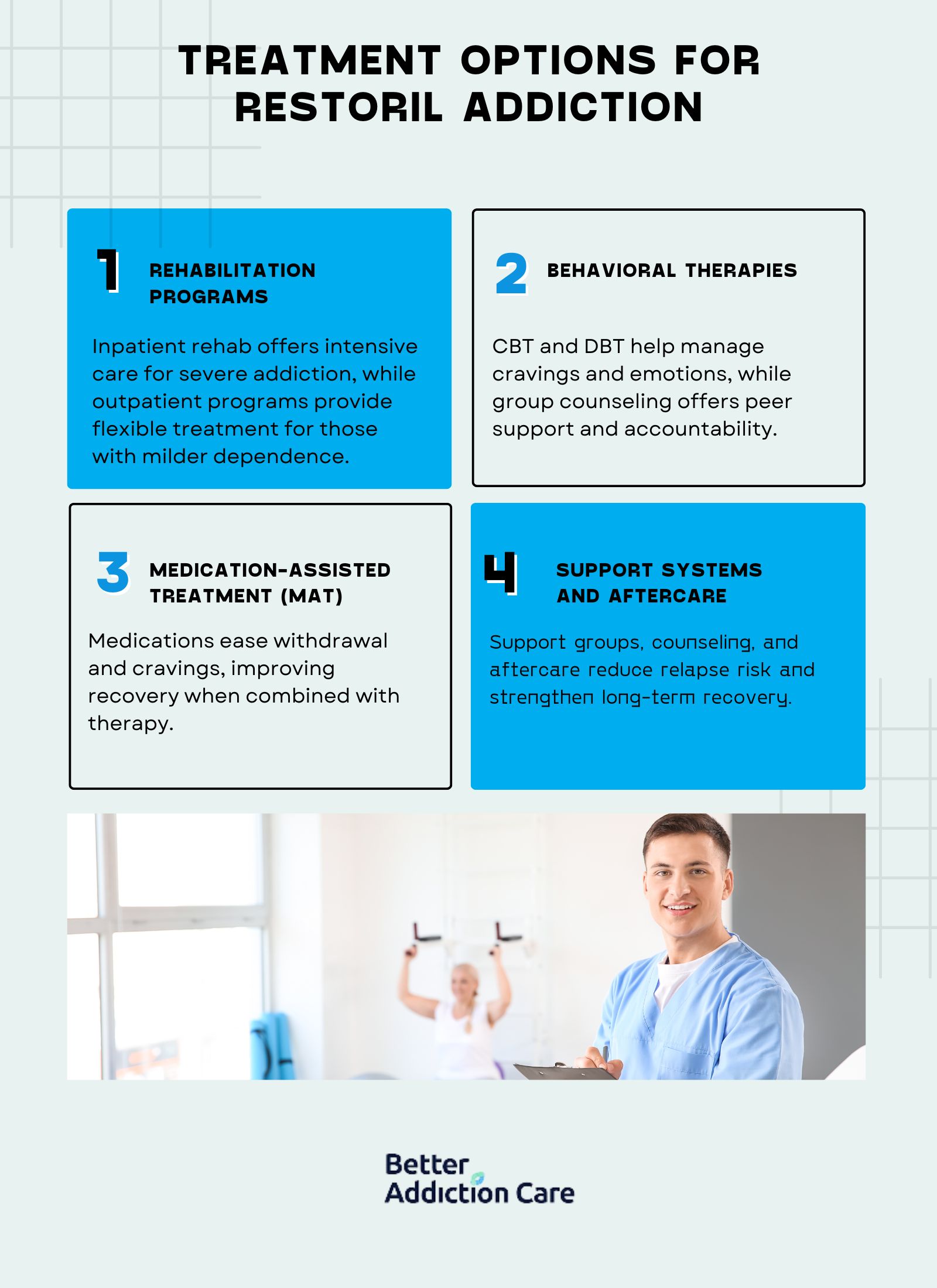
The treatment options for restoril addiction are listed below:
1. Inpatient and Outpatient Rehabilitation Programs
Inpatient and outpatient rehabilitation programs are explained below:
-
Inpatient programs: Inpatient programs require individuals to reside at a treatment facility for the duration of their recovery, ranging from 28 days to several months. These programs provide 24/7 medical supervision, structured schedules, and intensive therapy sessions, ensuring a safe environment for detoxification and recovery.
Inpatient treatment is ideal for individuals with severe dependence, co-occurring mental health disorders, or a history of relapse. The structured environment reduces external triggers and provides immediate access to medical professionals in case of severe withdrawal symptoms.
Studies by the Substance Abuse and Mental Health Services Administration (SAMHSA) indicate that inpatient programs have a success rate of around 70% for sustained recovery when followed by aftercare programs.
-
Outpatient Treatment: Outpatient programs allow individuals to live at home while attending scheduled therapy and counseling sessions. These programs range in intensity from standard outpatient therapy to intensive outpatient programs (IOPs) requiring multiple hours of treatment per day.
Outpatient treatment is suitable for those with mild to moderate dependence or strong support systems at home. It allows patients to maintain work or family responsibilities while receiving care. Intensive outpatient programs also provide structured treatment without requiring residential stays.
Outpatient services in the U.S., typically include medication-assisted treatment (MAT), behavioral therapies, and support group participation. SAMHSA reports that outpatient programs have a success rate of approximately 55% for individuals with moderate dependency who adhere to their treatment plans.
2. Behavioral Therapies
Behavioral therapies play a vital role in treating Restoril addiction by addressing the psychological and emotional aspects of dependence. These therapies help individuals understand the triggers for their substance use, develop healthier coping mechanisms, and rebuild their lives without reliance on benzodiazepines. According to the National Institute on Drug Abuse (NIDA), combining behavioral therapies with other treatments increases long-term success rates for addiction recovery.
The behavioral therapies for restoril addiction include:
-
Cognitive Behavioral Therapy (CBT): CBT helps individuals identify and change negative thought patterns and behaviors that contribute to their addiction. By focusing on the relationship between thoughts, feelings, and actions, CBT equips patients with practical tools to manage cravings, reduce stress, and prevent relapse. A study by Otto et al., published in The American Journal of Psychiatry (1993), highlights the efficacy of CBT in treating benzodiazepine dependence, showing reduced relapse rates and improved emotional regulation.
-
Dialectical Behavior Therapy (DBT): DBT focuses on emotional regulation, distress tolerance, and mindfulness, making it particularly useful for individuals with co-occurring mental health conditions like anxiety or PTSD. This therapy teaches patients to manage intense emotions without turning to substances like Restoril, improving their ability to cope with stress.
-
Group Counseling: counseling fosters a supportive environment where individuals share experiences, learn from others, and build accountability networks. Participation in group therapy reduces feelings of isolation and provides practical insights and encouragement from peers in similar situations. Studies by SAMHSA indicate that group counseling, when combined with other therapies, increases treatment retention and overall recovery success rates.
3. Medication-Assisted Treatment (MAT)
Medication-assisted treatment (MAT) supports recovery from Restoril addiction by alleviating withdrawal symptoms, reducing cravings, and stabilizing brain chemistry during the recovery process.
Medications such as flumazenil, a benzodiazepine receptor antagonist, are used to manage acute withdrawal symptoms safely, while longer-term treatments like antidepressants may address co-occurring mental health conditions such as anxiety or depression.
According to the National Institute on Drug Abuse (NIDA), MAT is highly effective when combined with behavioral therapies, with studies showing up to a 60% reduction in relapse rates for benzodiazepine addiction.
The safety of MAT lies in its careful administration under medical supervision, and its recommended duration varies based on individual needs, ranging from a few weeks during detoxification to several months during rehabilitation.
4. Support Systems and Aftercare
Support systems such as group therapy, family counseling, and ongoing individual counseling are essential components of maintaining recovery from Restoril addiction. Support groups like Narcotics Anonymous provide a sense of community, reduce isolation, and offer accountability, while family therapy helps rebuild trust and repair relationships impacted by addiction.
Aftercare, including regular counseling sessions and access to support networks, plays a critical role in reducing relapse risk by addressing long-term triggers and reinforcing coping strategies.
According to the Substance Abuse and Mental Health Services Administration (SAMHSA), individuals who participate in structured aftercare programs have significantly higher recovery success rates compared to those who do not.
How to Prevent Relapse From Restoril Addiction?
To prevent relapse from Restoril addiction, individuals should follow a structured aftercare plan that includes regular counseling, participation in support groups, and ongoing medical monitoring. According to the National Institute on Drug Abuse (NIDA), these strategies help individuals manage triggers and maintain long-term recovery by reinforcing healthy coping mechanisms.
The ways to prevent relapse from Restoril addiction are explained below:
-
Develop Healthy Coping Skills: Learn techniques such as mindfulness, deep breathing exercises, and stress management to handle triggers without turning to Restoril. These practices help regulate emotions and reduce the likelihood of relapse.
-
Engage in Sober Living: Transitioning to a sober living environment provides a structured, drug-free space where individuals focus on recovery. Sober living homes often include peer support and accountability, promoting sustained sobriety.
-
Establish a Routine: Maintaining a consistent daily schedule reduces idle time and helps individuals stay focused on recovery goals. Activities like regular exercise, meal planning, and sleep hygiene support both physical and mental well-being.
-
Build a Strong Support Network: Surrounding yourself with supportive family, friends, or recovery groups fosters accountability and provides encouragement during challenging times. Support networks are crucial for addressing feelings of isolation.
-
Participate in Continued Therapy: Regular sessions with a counselor or therapist help address ongoing emotional or psychological challenges. Therapy also reinforces coping mechanisms learned during treatment.
-
Avoid High-Risk Situations: Identify and avoid environments or people associated with past substance use. Creating a plan to handle unavoidable high-risk situations is equally important.
-
Set Realistic Goals: Break recovery into manageable milestones to maintain motivation and celebrate progress. Short-term goals, like attending weekly meetings, help you stay focused on long-term sobriety.
-
Stay Educated About Addiction: Understanding the science behind addiction and the specific risks of Restoril misuse helps individuals stay informed and committed to their recovery journey.
-
Pursue Hobbies and Interests: Engaging in fulfilling activities provides positive outlets for energy and focus, reducing the temptation to use substances.
-
Use Medication-Assisted Treatment (MAT) When Needed: For some, medications that manage withdrawal symptoms or cravings help maintain recovery under medical supervision.
How Does Restoril Addiction Differ From Diazepam Addiction?
Restoril addiction differs from diazepam addiction in terms of onset of action, duration of effects, and withdrawal severity.
Diazepam, known by the brand name Valium, is a long-acting benzodiazepine often prescribed for anxiety, muscle spasms, and seizures, while Restoril is an intermediate-acting benzodiazepine used primarily for short-term insomnia treatment.
Restoril’s faster onset and shorter half-life increase the likelihood of misuse for immediate effects, while diazepam’s prolonged action leads to slower dependency development but more sustained withdrawal symptoms.
According to the National Institute on Drug Abuse (NIDA), approximately 17% of benzodiazepine-related emergency room visits involve diazepam, highlighting its widespread misuse.
Withdrawal from Restoril includes severe rebound insomnia and anxiety, whereas diazepam withdrawal, though slower to manifest, is associated with prolonged physical symptoms like tremors and seizures.
Both drugs have high addiction potential, requiring similar treatment methods such as tapering and therapy to manage dependence safely.
How Does Restoril Addiction Differ From Ativan Addiction?
Restoril addiction differs from Ativan addiction in its prescribed uses, duration of action, and withdrawal symptoms. Ativan, or lorazepam, is a short-acting benzodiazepine prescribed for anxiety, seizure disorders, and preoperative sedation, while Restoril is an intermediate-acting benzodiazepine primarily used for treating insomnia.
Ativan’s shorter half-life increases the likelihood of more frequent dosing and faster dependency, whereas Restoril’s intermediate duration makes rebound insomnia a more prominent withdrawal symptom.
Both drugs share high addiction potential; according to a report by the National Institute on Drug Abuse (NIDA), lorazepam misuse contributes to over 20% of benzodiazepine-related emergency room visits, underscoring its widespread abuse.
Withdrawal from Ativan includes severe anxiety, physical restlessness, and muscle pain, while Restoril withdrawal is marked by insomnia and psychological cravings. Treatment for both drugs requires medical supervision, tapering, and behavioral therapies to manage dependency effectively.
How Does Restoril Addiction Differ From Ambien Addiction?
Restoril addiction differs from Ambien addiction through its drug classifications, primary uses, and withdrawal symptoms. Ambien, or zolpidem, is a non-benzodiazepine sedative-hypnotic explicitly prescribed for short-term insomnia treatment, while Restoril is an intermediate-acting benzodiazepine also used to address sleep disorders but with broader sedative properties.
Restoril has a higher risk of physical dependence due to its benzodiazepine classification, while Ambien’s potential for psychological dependence stems from its quick action in inducing sleep.
Withdrawal from Restoril commonly includes rebound insomnia, severe anxiety, and physical symptoms like tremors, whereas Ambien withdrawal is characterized by intense cravings, irritability, and rebound insomnia.
According to the Substance Abuse and Mental Health Services Administration (SAMHSA), Ambien was involved in 8,000 emergency room visits related to misuse in 2011, highlighting its potential for abuse. Both drugs require supervised tapering and integrated treatment plans for effective recovery.
Are There Safer Alternatives for Sleep Disorders?
Yes, there are safer alternatives for treating sleep disorders compared to Restoril, including non-habit-forming medications and behavioral interventions. Cognitive Behavioral Therapy for Insomnia (CBT-I) is widely recommended as the first-line treatment because it addresses the underlying causes of sleep disturbances without medication.
Additionally, medications like melatonin supplements or antihistamines, which have a lower risk of dependency, are used for short-term relief. According to the American Academy of Sleep Medicine, CBT-I has shown sustained improvement in sleep quality for up to 70% of patients, outperforming pharmacological approaches in the long term.
While Restoril is effective for short-term use, these alternatives provide a safer, sustainable approach to managing chronic sleep issues.
How Does Restoril Addiction Affect Mental Health?
Restoril addiction severely impacts mental health by exacerbating anxiety, depression, and emotional instability. Prolonged misuse disrupts the brain’s natural neurotransmitter balance, leading to heightened anxiety and depressive symptoms when the drug is absent.
Additionally, dependency on Restoril causes cognitive impairments, such as memory loss and difficulty concentrating, which further affect emotional well-being.
According to the National Institute on Drug Abuse (NIDA), individuals addicted to benzodiazepines are at a significantly higher risk of developing co-occurring mental health disorders, including major depressive disorder and generalized anxiety disorder.
These effects emphasize the importance of addressing both addiction and mental health in recovery programs to achieve lasting results.
Should You Take Restoril if You Are Pregnant?
No, you should not take Restoril if you are pregnant due to the significant risks it poses to both the mother and the fetus. Restoril is classified as a Category X medication by the FDA, indicating that studies have shown clear evidence of harm to the fetus, including congenital malformations and neonatal withdrawal symptoms.
Prenatal exposure to benzodiazepines like Restoril has been associated with respiratory issues, low birth weight, and developmental delays in newborns.
The American College of Obstetricians and Gynecologists (ACOG) strongly advises against the use of benzodiazepines during pregnancy and recommends safer alternatives, such as cognitive behavioral therapy or non-pharmacological approaches, for managing insomnia or anxiety during this period.
How Much Restoril is Too Much?
The amount of Restoril that is too much is any dose exceeding the prescribed range, between 7.5 mg and 30 mg per day, for short-term treatment of insomnia. Doses higher than this, especially when taken without medical supervision, lead to overdose, marked by symptoms such as extreme drowsiness, confusion, respiratory depression, and loss of consciousness.
In severe cases, taking too much Restoril results in life-threatening complications, including coma or death, particularly when combined with other central nervous system depressants like alcohol or opioids.
According to the Substance Abuse and Mental Health Services Administration (SAMHSA), benzodiazepines like Restoril are involved in over 30% of prescription drug overdose deaths, emphasizing the critical importance of adhering to prescribed doses and seeking medical help if misuse occurs.
Is There a Difference Between Physical Dependence and Addiction to Restoril?
Yes, there is a difference between physical dependence and addiction to Restoril. Physical dependence occurs when the body adapts to the drug’s presence, leading to withdrawal symptoms if usage is abruptly stopped.
This is a physiological response that can happen even with prescribed use over an extended period. Addiction, on the other hand, involves compulsive drug-seeking behavior and misuse despite negative consequences, encompassing both physical and psychological aspects.
According to the National Institute on Drug Abuse (NIDA), while dependence can occur without addiction, addiction always includes dependence along with behavioral patterns that disrupt daily life.


